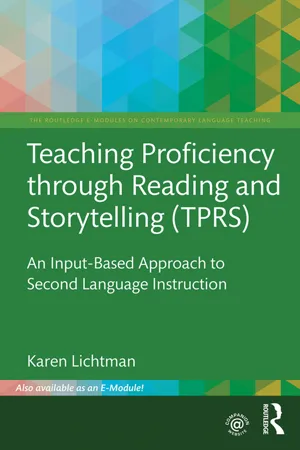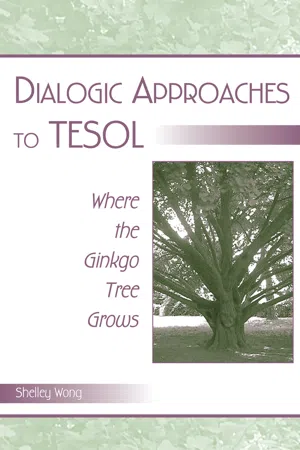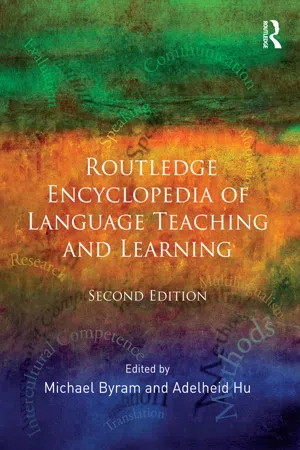Languages & Linguistics
Total Physical Response
Total Physical Response (TPR) is a language teaching method that involves the use of physical movement to reinforce language learning. It is based on the idea that language learning is most effective when it is accompanied by physical actions. TPR is often used with beginners and young learners.
Written by Perlego with AI-assistance
Related key terms
Related key terms
1 of 4
Related key terms
1 of 3
3 Key excerpts on "Total Physical Response"
- eBook - ePub
Teaching Proficiency Through Reading and Storytelling (TPRS)
An Input-Based Approach to Second Language Instruction
- Karen Lichtman(Author)
- 2018(Publication Date)
- Routledge(Publisher)
yes/no or other one-word answers without ever being pushed to create full sentences. Student errors are not corrected, and students never participate in language practice typical of many language classes. The Natural Approach posited that activities should be intrinsically motivating to the students. For instance, the teacher might tell a story about a cultural misunderstanding or lead the class to play a simple game such as “Go, Fish” using the target language.The Natural Approach focused on comprehensible input and not forcing students to speak. These same principles were also key to an approach called Total Physical Response (TPR) , which was developed by James Asher starting in the mid-1960s. The inspiration for TPR came from watching the process of first language acquisition in young children. Asher observed that early communication with babies and toddlers often took the form of a verbal utterance by the parent followed by a physical response from the child. In a TPR lesson, the teacher gives many verbal commands to the whole class, individual students, and groups of students. The meaning of the commands is made clear through physical actions. For instance, a beginning TPR command is “stand up.” The teacher will say, “stand up” in the target language, stand up himself, and perhaps gesture for the students to stand up (and expect them to do so!). Since the meaning is clear, no translation or use of the first language is needed. Hearing the language before being asked to produce it aligns with natural acquisition, and provides the data necessary for learners to begin building an unconscious mental representation of language. TPR is still used today, particularly with younger students and absolute beginners.Reflection None of the methods or approaches just reviewed are widespread in the United States. Why do you think this is so? Why isn’t “everyone” doing some kind of input-based approach in the classroom?Teaching Proficiency Through Reading and Storytelling (TPRS)
TPR as developed by James Asher is very effective for learning concrete vocabulary, such as physical actions and items in a classroom. However, it would be difficult to express the meaning of more abstract vocabulary, such as “democracy,” “idea,” or “misses someone,” through a physical action. This problem was the inspiration for Teaching Proficiency through Reading and Storytelling, or TPRS. Blaine Ray, who developed TPRS, wanted to be able to teach more abstract vocabulary while retaining the benefits of TPR. Ray was a high school Spanish teacher in California. In the late 1980s, he started using TPR and elements of the Natural Approach in his classes. He found that students were very successful at the beginning of the school year, but that at some point, they would get bored with doing TPR, and he would have to resort to more traditional materials. So Ray developed what he originally called TPR Storytelling (Total Physical Response Storytelling). In 1990, he published a level 1 Spanish curriculum using his new method, titled Look, I Can Talk . In 1997, the first book explaining TPRS, Fluency through TPR Storytelling: Achieving real language acquisition in school - eBook - ePub
Dialogic Approaches to TESOL
Where the Ginkgo Tree Grows
- Shelley Wong(Author)
- 2022(Publication Date)
- Routledge(Publisher)
the greatest use of active participation, including gestures and bodily movement? (a) Cognitive Code Learning, (b) Total Physical Response, (c) Natural Approach, (d) Direct Method” (italics added). One may speculate the “correct” answer, Total Physical Response (TPR), is a language teaching method built around the coordination of speech and action; it attempts to teach language through physical (motor) activity. Therefore, B is the correct answer.” The item reflected the test makers’ U.S.-centric or a historical lack of knowledge of the direct method.The Reading Approach
The reading approach—which was prominent in the United States in the 1930s and 1940s until World War II, stressed reading. The Coleman Re-port of 1929 set reading as the major goal for foreign language instruction in the United States, based on a number of factors. A study of foreign language teaching in the United States had revealed that there was a lack of sufficiently trained foreign language teachers. Few teachers had native-like competency to utilize the target language almost exclusively in instruction without a textbook. The direct method required that teachers be fluent in the foreign language. The Coleman Report also argued that it was not important for secondary and college students who might never go abroad to study conversation. These students could benefit from reading and learning about the history of other countries. Unlike the grammar translation and the direct method, the reading approach did not emphasize the teaching of grammatical structures. Students were introduced only to grammar that was needed for reading comprehension. The reading approach was the only dominant approach in the United States that was not structural in nature.The Audiolingual Approach
The audiolingual approach (sometimes in the U.S. called the Army Method) got a boost in World War II when the United States needed to train military personnel for active communication, including intercepting messages and interrogating prisoners. The reading approach, which did not prepare students to speak, was inadequate. With the expansion of the war to Asia and the Pacific there was also a need to train personnel in non-European languages. The Army Specialized Training Program (ASTP) enlisted linguists such as Leonard Bloomfield at Yale, who designed the methodology and materials to train the military (Richards & Rogers, 1986). - Michael Byram, Adelheid Hu(Authors)
- 2013(Publication Date)
- Routledge(Publisher)
linguistics which has shaped present-day teaching methods.The communicative approach (communicative language teaching) has been widely accepted and may be seen as an umbrella under which a number of methods have found their place (see Waters (2009) for an unusual, yet thought-provoking overview): natural approach, task-based learning, community language learning, humanistic methods, content-based instruction, bilingual method, and, to a lesser degree Total Physical Response (TPR) and suggestopedia. The role of the senses in understanding and handling the foreign language is important in the audio-visual method, TPR, task-based learning and humanistic methods. A strong cognitive element is present in the silent way and the grammar–translation method. Cognitive learning does not play a big part in the audio-lingual method or TPR. More than any other method, community language learning takes the needs and the individuality of the learner as its focal point (Stevick, 1998 ). But the individual learner matters in all communicative methods. After all, the main objective of communicative language teaching is to enable the learner to express in the foreign language what he or she would like to express.The main purpose of a teaching method lies in facilitating learning. Thus, the method needs to suit the goals set in the language classroom, i.e. the effective and efficient acquisition of the new language. Swan criticises recent preoccupation with peripheral issues:In replacing old methods by new ones, we have often allowed new and promising-looking macrostrategical stances to dictate our acceptance or rejection of micromethods, whose value should in fact be judged solely by their efficacy. [ … ] What we need, perhaps, is therefore not so much to find new methods, as to take stock of the existing ones.
Index pages curate the most relevant extracts from our library of academic textbooks. They’ve been created using an in-house natural language model (NLM), each adding context and meaning to key research topics.
Explore more topic indexes
Explore more topic indexes
1 of 6
Explore more topic indexes
1 of 4


